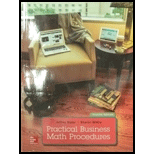
Concept explainers
a.
To fill: The statement “7% of 74 is ________” with the correct portion and round the portion to the nearest hundredth if necessary.
b.
To fill: The statement “12% of 205 is ________” with the correct portion and round the portion to the nearest hundredth if necessary.
c.
To fill: The statement “16% of 630 is ________” with the correct portion and round the portion to the nearest hundredth if necessary.
d.
To fill: The statement “7.5% of 920 is ________” with the correct portion and round the portion to the nearest hundredth if necessary.
e.
To fill: The statement “25% of 1,004 is ________” with the correct portion and round the portion to the nearest hundredth if necessary.
f.
To fill: The statement “10% of 79 is ________” with the correct portion and round the portion to the nearest hundredth if necessary.
g.
To fill: The statement “103% of 44 is ________” with the correct portion and round the portion to the nearest hundredth if necessary.
h.
To fill: The statement “30% of 78 is ________” with the correct portion and round the portion to the nearest hundredth if necessary.
i.
To fill: The statement “0.2% of 50 is ________” with the correct portion and round the portion to the nearest hundredth if necessary.
j.
To fill: The statement “1% of 5,622 is ________” with the correct portion and round the portion to the nearest hundredth if necessary.
k.
To fill: The statement “
l.
To fill: The statement “150% of 10 is ________” with the correct portion and round the portion to the nearest hundredth if necessary.
m.
To fill: The statement “100% of 34 is ________” with the correct portion and round the portion to the nearest hundredth if necessary.
n.
To fill: The statement “
Want to see the full answer?
Check out a sample textbook solution
Chapter 6 Solutions
Practical Business Math Procedures
- 39 Two sides of one triangle are congruent to two sides of a second triangle, and the included angles are supplementary. The area of one triangle is 41. Can the area of the second triangle be found?arrow_forwardPls help ASAP botharrow_forwardK Find all values x = a where the function is discontinuous. For each value of x, give the limit of the function as x approaches a. Be sure to note when the limit doesn't exist. x-7 p(x) = X-7 Select the correct choice below and, if necessary, fill in the answer box(es) within your choice. (Use a comma to separate answers as needed.) OA. f is discontinuous at the single value x = OB. f is discontinuous at the single value x= OC. f is discontinuous at the two values x = OD. f is discontinuous at the two values x = The limit is The limit does not exist and is not co or - ∞. The limit for the smaller value is The limit for the larger value is The limit for the smaller value is The limit for the larger value does not exist and is not c∞ or -arrow_forward
- K x3 +216 complete the table and use the results to find lim k(x). If k(x) = X+6 X-6 X -6.1 -6.01 - 6.001 - 5.999 - 5.99 -5.9 k(x) Complete the table. X -6.1 -6.01 - 6.001 - 5.999 - 5.99 - 5.9 k(x) (Round to three decimal places as needed.) Find the limit. Select the correct choice below and, if necessary, fill in the answer box within your choice.arrow_forwardexplain as wellarrow_forwardPls help ASAP botharrow_forward
- Explain as wellarrow_forwardPls help ASAP botharrow_forward5. The revenue function for a school group selling n cookies is given by R(n) = 2n, and the total cost function is given by C(n) = 45+0.20n a) Determine a simplified equation for the profit function, P(n). b) Determine the number of cookies that need to be sold for the school group to break even.arrow_forward
 Discrete Mathematics and Its Applications ( 8th I...MathISBN:9781259676512Author:Kenneth H RosenPublisher:McGraw-Hill Education
Discrete Mathematics and Its Applications ( 8th I...MathISBN:9781259676512Author:Kenneth H RosenPublisher:McGraw-Hill Education Mathematics for Elementary Teachers with Activiti...MathISBN:9780134392790Author:Beckmann, SybillaPublisher:PEARSON
Mathematics for Elementary Teachers with Activiti...MathISBN:9780134392790Author:Beckmann, SybillaPublisher:PEARSON
 Thinking Mathematically (7th Edition)MathISBN:9780134683713Author:Robert F. BlitzerPublisher:PEARSON
Thinking Mathematically (7th Edition)MathISBN:9780134683713Author:Robert F. BlitzerPublisher:PEARSON Discrete Mathematics With ApplicationsMathISBN:9781337694193Author:EPP, Susanna S.Publisher:Cengage Learning,
Discrete Mathematics With ApplicationsMathISBN:9781337694193Author:EPP, Susanna S.Publisher:Cengage Learning, Pathways To Math Literacy (looseleaf)MathISBN:9781259985607Author:David Sobecki Professor, Brian A. MercerPublisher:McGraw-Hill Education
Pathways To Math Literacy (looseleaf)MathISBN:9781259985607Author:David Sobecki Professor, Brian A. MercerPublisher:McGraw-Hill Education





